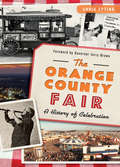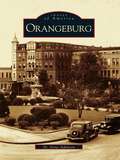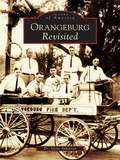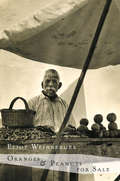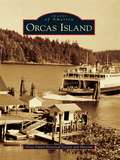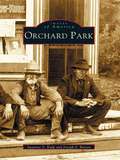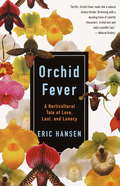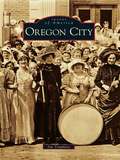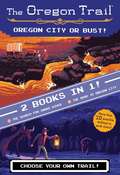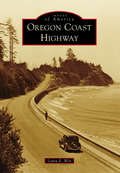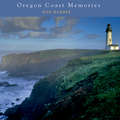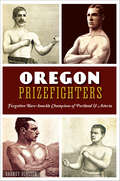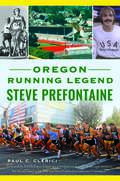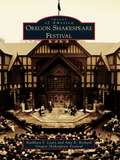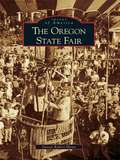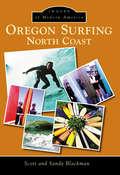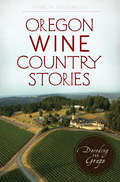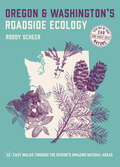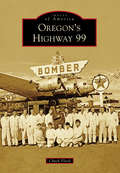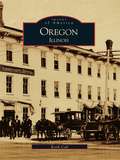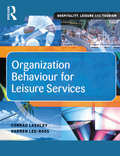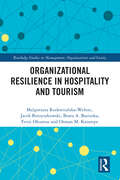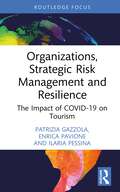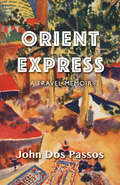- Table View
- List View
Orange County Fair, The: A History of Celebration
by Chris Epting Governor Jerry BrownThe Orange County Fair is one of Southern California's most anticipated summer events. From its first year in 1890 with a few livestock exhibits and horse races, the fair evolved into what is now a month-long extravaganza of rides, games and entertainment that still celebrates the importance of local agriculture. Millions of visitors have crowded the grounds over the years to enjoy the spectacle of everything from ostrich races and demolition derbies to its unique Centennial Farm and the time-honored All-Alaskan pig race. Author Chris Epting recounts more than a century of community history and revelry at the OC Fair.
Orangeburg
by Dr Gene AtkinsonLocated along the north fork of South Carolina's Edisto River, Orangeburg enjoys an extended, rich heritage dating back to the 1730s when it was created as one of the original inland townships. The first settlers were mostly German and Swiss immigrants who found the area to be the paragon of locales, valuable in fertile soil and abundant wildlife surrounding the river. The city of today has been gently shaped by its landscape and natural life, which called people and industries to experience the benefits of such land. This volume celebrates Orangeburg's history by offering readers a rare find of more than 200 photographs from days gone by, taking them on an adventure through the town's coming of age, from the early days of photography to the 1950s. These images reveal the ways of life long past by showcasing well-known town entities such as the Courthouse Square and the Edisto Memorial Gardens, local businesses like the Orangeburg Hotel, and beloved residents, some of whom were public figures and others better remembered by their families and friends. From early-century churches to the evolution of the county fair, readers will find themselves enthralled by the history that Orangeburg possesses.
Orangeburg Revisited
by Dr Gene AtkinsonOrangeburg, South Carolina, is home to an abundant history, shown in this second volume through over 225 rare images of times gone by. The epitome of the small town, Orangeburg is where friends would gather at the famous Bluebird Theatre or the old soda fountains at a turn-of-the-century drugstore. Residents marveled when the Orangeburg Hotel was constructed in 1909; at the time it was the second tallest structure in all of South Carolina. Marchant Music Co., whose showroom is featured in this volume, recalls the days when everyone gathered around the piano in the parlor. Beauty queens from the old Fall Festival, which preceded the formation of the Orangeburg County Fair, grace the pages of this collection. Even the first motor-powered fire truck makes an appearance, as do the stalwart men who comprised the old volunteer fire departments. Also notable in this volume is the rarely mentioned George H. Cornelson, who had more impact on the city than any other person over the last 130 years.
Oranges & Peanuts for Sale
by Eliot WeinbergerPresented at the PEN World Voices Festival as a "post-national" writer, Eliot Weinberger is "a sparkling essayist" (Confrontation), and his writings "a boundary-crossing, shape-shifting cabinet of curiosities" (The Bloomsbury Review). Many of the twenty-eight essays in Oranges & Peanuts for Sale have appeared in translation in seventeen countries; some have never been published in English before. They include introductions for books of avant-garde poets; collaborations with visual artists, and articles for publications such as The New York Review of Books, The London Review of Books, and October. One section focuses on writers and literary works: strange tales from classical and modern China; the Psalms in translation: a skeptical look at E. B. White's New York. Another section is a continuation of Weinberger's celebrated political articles collected in What Happened Here: Bush Chronicles (a finalist for the National Books Critics Circle Award), including a sequel to "What I Heard About Iraq," which the Guardian called the only antiwar "classic" of the Iraq War. A new installment of his magnificent linked "serial essay," An Elemental Thing, takes us on a journey down the Yangtze River during the Sung Dynasty. The reader will also find the unlikely convergences between Samuel Beckett and Octavio Paz, photography and anthropology, and, of course, oranges and peanuts, as well as an encomium for Obama, a manifesto on translation, a brief appearance by Shiva, and reflections on the color blue, death, exoticism, Susan Sontag, and the arts and war.
Orcas Island
by Orcas Island Historical Society and MuseumOrcas Island, the largest of the 172 islands in San Juan County, lies in the Salish Sea north of Puget Sound. Known as the "Gem of the San Juans" for her shimmering emerald hills bounded by 125 miles of rocky, tree-lined shore, Orcas was home to countless generations of Native Americans before the arrival of its first white settlers, formerly Hudson's Bay men who had hunted on the island, in the late 1850s. An international boundary dispute, popularly known as the Pig War, prevented early pioneers from settling land claims until the dispute was resolved by the German kaiser in 1872. Settlement grew slowly until improved steamship routes and increased commerce brought more tourists to the island. In 1906, Robert Moran built a fabulous estate, Rosario, now a world-class resort. Thousands of visitors have been coming to Orcas Island over the years to explore her forested hills, camp in Moran State Park or stay at one of the many historic resorts, and fish in the pristine waters surrounding this island paradise.
Orchard Park
by Joseph F. Bieron Suzanne S. KulpAttracted by the fertile soil, ample forests, and abundant water, the first pioneer arrived in the Orchard Park area in 1803, making this one of the earliest settlements in western New York. Prominent among the settlers were the Quakers, who built a picturesque meetinghouse that is still in use today. Orchard Park portrays the history of the community through its citizens and their homes and businesses, many of which were at Four Corners. Plank roads and then a railroad and finally a trolley provided opportunities for the community to share in the prosperity of nearby Buffalo in the late 1800s. Old family heritage persists in the names of streets on which century-old houses still stand, connecting yesterday with today.
Orchid Fever: A Horticultural Tale of Love, Lust, and Lunacy
by Eric HansenThe acclaimed author of Motoring with Mohammed brings us a compelling adventure into the remarkable world of the orchid and the impossibly bizarre array of international characters who dedicte their lives to it.The orchid is used for everything from medicine for elephants to an aphrodisiac ice cream. A Malaysian species can grow to weigh half a ton while a South American species fires miniature pollen darts at nectar-sucking bees. But the orchid is also the center of an illicit international business: one grower in Santa Barbara tends his plants while toting an Uzi, and a former collector has been in hiding for seven years after serving a jail sentence for smuggling thirty dollars worth of orchids into Britain. Deftly written and captivatingly researched, Orchid Fever is an endlessly enchanting and entertaining tour of an exotic world."A wonderful book, I've been up all night reading it, laughing and crying out in horror and clucking at the vivid images of bureaucracy with the bit in its teeth." --Annie Proulx"An extraordinary, well-told tale of botany, obsession and plant politics. Hansen's vivid descriptions of the complex techniques some orchids use to pollinate themselves will raise your eyebrows at nature's sexual ingenuity." --USA Today
Ordeal by Hunger: The Story of the Donner Party
by George R. StewartThe tragedy of the Donner party constitutes one of the most amazing stories of the American West. In 1846 eighty-seven people -- men, women, and children -- set out for California, persuaded to attempt a new overland route. After struggling across the desert, losing many oxen, and nearly dying of thirst, they reached the very summit of the Sierras, only to be trapped by blinding snow and bitter storms. Many perished; some survived by resorting to cannibalism; all were subjected to unbearable suffering. Incorporating the diaries of the survivors and other contemporary documents, George Stewart wrote the definitive history of that ill-fated band of pioneers.
Oregon City
by Jim TompkinsIn 1829, Dr. John McLoughlin, chief factor of the Hudson's Bay Company Columbia Department, had two small cabins constructed on an island in Willamette Falls. The Kalapuya Indians promptly burned them, but a claim had been made and the roots planted for the oldest city in the Oregon Territory. Incorporated for over 160 years as Oregon City, McLoughlin's city at Willamette Falls has served as the political capital of an independent Oregon Country and the first capital of the Oregon Territory. Considered the oldest industrial site in the West, with saw, flour, paper, and woolen mills, Oregon City was also a transportation center for covered wagons, steamboats, and railroads. As a regional entertainment hub over the years, the community has provided both residents and visitors with such pleasures as Chautauquas, Oregon's first sporting events, the first state fair, a variety of annual festivals, and an array of opera, vaudeville, and movie houses.
Oregon City or Bust!: The Search for Snake River and The Road to Oregon City (The Oregon Trail)
by Jesse WileyExplore the frontier, young pioneer! Inside, find two choose your own trail books in one: The Search for Snake River and The Road to Oregon. In these last two legs of your trek on the Oregon Trail, you're halfway to Oregon City, but do you have the grit to make it there? The wild frontier is full of risks and surprises! Continue your journey West and reach your final destination—if you can make the right decisions!
Oregon Coast Highway (Images of America)
by Laura E. WiltBy the time the final links in the Oregon Coast Highway were made in 1936, the highway stretched 394 miles from Astoria to the border of California. It had taken 12 years to complete the construction over stretches of rugged headlands and thick forests. Early travel along the coast was difficult; what roads existed were generally unimproved and often completely impassable during the rainy winter months. In many cases, the beaches themselves served as the only means of transporting freight and passengers. When Maj. Henry Bowlby, the first Oregon State Highway engineer, outlined a proposed system of state highways in 1914, he presented the vision of a coastal highway to the Oregon State Highway Commission. The eventual construction of this highway opened access to the Willamette Valley and beyond for many formerly isolated coastal communities. It also signaled an economic shift that included the promotion of tourism and the accommodation of the flood of visitors anxious to take advantage of the spectacular vistas along the Oregon coast.
Oregon Coast Memories
by Rod BarbeeA beautiful photo essay of the majestic purples of the Oregon coast, the perfect memento for any visitor to this unforgettable place. When your own photographs of the gorgeous places you visit can’t quite match what you have seen—a breathtaking coastline, a boulevard bustling with character, or iconic and famous monuments—you’ll want to take home a memento to capture the depth and substance of your experience. Now you can. Introducing a new series of beautiful photographic essays that let you relive—or see for the first time through an artist’s eye—the jagged vistas of the Maine coast; the gardens, malls, and iconic edifices of our nation’s capital; and the majestic purples of Oregon’s coast. The Memories series aims to celebrate the beauty and unique character of those destinations in America that are simply unforgettable.
Oregon Prizefighters: Forgotten Bare-knuckle Champions of Portland & Astoria (Sports)
by Barney BlalockIn 1884, London's prizefighting craze spread to Portland. Since the fights were illegal throughout the States, matches were fought in inconspicuous venues away from unwanted spectators. A winner could be hanged if the loser died. Champions like Dave Campbell, Jack "Nonpareil" Dempsey and "Mysterious" Billy Smith were just a few contenders for the brutal, nearly forgotten sport. Join author Barney Blalock as he reveals the remarkable stories of Oregon's bare-knuckle champions.
Oregon Running Legend Steve Prefontaine (Sports)
by Paul C. Clerici Pat TysonIn the Footsteps of Oregon's beloved U.S. Olympic Athlete, Activist, and IconBorn in the small town of Coos Bay, Oregon, Steve "Pre" Prefontaine's meteoric rise to cross-country and track superstardom included national recognition in high school followed by state, national, and world records. From the University of Oregon track to a fourth-place finish in the 1972 Munich Olympic Games, he never stopped striving to make his mark on the world. Even today, his name conjures up images of athleticism, activism, and charisma. While his life tragically ended in a car accident at the youthful age of 24 - at which time he owned every American record from 2,000 to 10,000 meters and two to six miles - his legacy lives on.Join author and runner Paul C. Clerici as he brings you this legendary Oregon athlete.
Oregon Shakespeare Festival
by Kathleen F. Leary Amy E. Richard Oregon Shakespeare FestivalIn 1935, Angus Bowmer, an instructor at Southern Oregon Normal School in Ashland, began with a dream and a small coterie of devoted friends who believed, as he did, in the value of Shakespeare performed on an Elizabethan stage. Though the Oregon Shakespeare Festival's early platforms were rudimentary and the backstage areas primitive, the art drew enthusiastic audiences. The urgency of World War II closed the festival's doors, but in 1947 it reopened with larger theater facilities and an expanded repertory, winning the support and respect of state, regional, and national artists and dignitaries. In a setting of extraordinary beauty and a community dedicated to culture and the arts, the 75-year-old Oregon Shakespeare Festival (OSF) is among the largest and most influential professional regional theaters in North America.
Oregon State Fair, The (Images of America)
by Steven Robert HeineSince the first Oregon State Fair was held on four acres along the Clackamas River in the Gladstone/Oregon City area in 1861, the fair has been the focal point of Oregon culture--a place to seeand be seen and to compete against the best in the state. It has been a place of victory and a place of discovery for nearly 150 years. For many generations of Oregonians, the fair was a chance for families and friends to reunite and share the excitement of this grand, uniquely Oregon event. Today the fair's popularity continues and, for 12 days each year, transforms the fairgrounds in Salem into the fifth largest city in the state.
Oregon Surfing: North Coast (Images of Modern America)
by Sandy Blackman Scott BlackmanSurfing culture began in Portland, Seaside, Cannon Beach, and Pacific City in the early 1960s. Influenced by surf music and a few California surfers, a handful of skin divers and adolescent boys yearned to engage in the sport. In the beginning, surfing was illegal along the beachfronts of Seaside and Cannon Beach. Answering the siren call, locals took to the beaches, while others from around Oregon, Washington, and California found their way to isolated spots along the Northern Oregon coast. The early surfers were not intimidated by their lack of knowledge, poor equipment, or the unpredictable waves. Instead, surfing caught on in the cold waters of Oregon. Experience the early days of Oregon surfing through the pioneer surfers' stories and vintage photographs.
Oregon Wine Country Stories: Decoding the Grape (American Palate)
by Kenneth FriedenreichJust fifty years ago, Oregon had no wine industry of consequence. Today, the state teems with a wine culture that matches the fecundity of its land and the vital spirit of its people. The pioneers who dared that tradition into being, from astrophysicists to cherry farmers to harpsichord makers, stand poised to pass on their legacy to an eager new generation. The bold experimentation of urban wineries now joins the steady contributions of outstanding producers like Bethel Heights, Cerulean Skies, Eyrie and Honeywood. Kenneth Friedenreich, a noted Oregon wine writer and an equally ardent Oregon wine devotee, seizes this moment of transition to probe the state's fascinating oenological frontiers and evaluate the repercussions of the industry's dramatic success. Based on dozens of interviews and even more glasses of wine, this drinking companion volume traverses the full range of Oregon's viticultural areas, providing useful AVA maps, historical photos and extensive winery listings.
Oregon and Washington's Roadside Ecology: 33 Easy Walks Through the Region's Amazing Natural Areas
by Roddy ScheerDiscover natural history secrets hiding in plain sight Have you ever seen a raging river disappear completely into a lava tube? Petrified subtropical plants in the middle of a high desert? Do you know how a 10,000-year-old argillite boulder can wind up 800 miles away from any similar rocks? In this insightful guide, environmental journalist and photographer Roddy Scheer reveals the hidden stories of the Pacific Northwest&’s unique ecosystems and teaches you how to &“read a landscape,&” as you explore 33 spectacular natural areas. All hikes are within easy walking distance of the road, less than two miles long, and include clues to deciphering the terrain—making Oregon and Washington&’s Roadside Ecology a must-have guide to some of the area&’s most spectacular and unusual natural sights.
Oregon's Highway 99 (Images of America)
by Chuck FloodFrom the Columbia River to the Siskiyou Mountains, Highway 99 traverses 300 miles of western Oregon. Big cities and small towns, the level Willamette Valley and steep hills, rich agricultural lands and tall evergreen forests, and rushing rivers all lie along its path. Arising from an early network of emigrant trails, stagecoach routes, and farm-to-market roads, the highway had developed into Oregon's major transportation corridor by the end of the 19th century. The dawn of the automobile age saw an exponential increase in traffic, creating a greater demand for improved roads; these better roads, in turn, created yet more traffic for both business and recreation. Roadside businesses, such as auto courts, restaurants, and service stations, sprang up along the highway to cater to a new type of motorist--the tourist. Today, much of Highway 99 and its predecessor, the Pacific Highway, remain in daily use.
Oregon, Illinois (Images of America)
by Keith CallOregon, Ill., the administrative seat of Ogle County, lies midway between Rockford and Dixon. From its four state parks to Stronghold Castle, and from quiet tree-lined avenues to the regal Blackhawk statue, Oregon has long provided a haven for tourists, campers, boy scouts, church retreats, and artists: anyone seeking a unique taste of small town Midwestern life. In the early 1830s, pioneer John Phelps journeyed into the Rock River valley, eager to explore. He befriended Native Americans and enjoyed the land, but harbored no intent to stay. However, he wrote that "these beautiful undulating and rich prairies left an impression on my memory that no time could erase." Thus, at the suggestion of surveyor Colonel William S. Hamilton, son of Alexander Hamilton, he built a cabin, planted a crop, and staked his claim. Others wisely followed Phelps, and have been following ever since. Through text and images,Oregon, Illinois seeks to chronicle the story of a most remarkable community whose rich heritage reaches back nearly to the founding of this nation.
Organization Behaviour for Leisure Services
by Darren Lee-Ross Conrad LashleyOrganization Behaviour for Leisure Services provides the reader with the conceptual tools necessary for analysing organizational behaviour in the context of hospitality, leisure and tourism provision, and understaanding events in order to take appropriate management action.Taking the view that leisure services involve an array of industry sectors - they are related, for instance, to work-time spent eating, drinking and staying away from home, as well as the more obvious recreational pursuits - the text uses examples and case studies from a wide range of international businesses such as hotels, restaurants, museums, shopping malls and sports stadia. Specific examples used are from Marriotts, McDonald's, Trafford Centre and many more. With a user-friendly structure and style, the text is an ideal introduction to the fundamental issues involved - perfect for students and managers alike. This book discusses and questions a number of key elements, including: The individual and the organization Groups in the organization Organizational structures and behaviour Management within the organization Commercial hospitality, leisure and tourism in a service context There is a Tutor Resource pack available to lecturers who adopt this text. Accredited lecturers can request access to download this material by going to http://books.elsevier.com/academic/defaultmanuals.asp? to request access.
Organizational Resilience in Hospitality and Tourism (Routledge Studies in Management, Organizations and Society)
by Fevzi Okumus Malgorzata Rozkwitalska-Welenc Jacek Borzyszkowski Beata A. Basinska Osman M. KaratepeAlthough ‘VUCA’ is not a new term, the features of the world it describes, a volatile, uncertain, complex and ambiguous environment, have never been more valid. The VUCA world has become the new reality for business, specifically for hospitality and tourism organizations that are more vulnerable than any other sector due to the historically-recognized turbulent environment in which they operate. In this book, the authors present unique factors that make hospitality and tourism organizations resilient in the VUCA world. With contacts at the center of their hospitality and tourism organizational resilience model, the organizational and psychological perspectives are also incorporated. This innovative volume tests the model of organizational resilience in hospitality and tourism organizations. The study identifies and validates organizational and individual factors that create a resilient organization in the hospitality and tourism sector. It will be of interest to researchers, academics, practitioners, and advanced students in the fields of organizational studies, strategic management, hospitality, and tourism management.
Organizations, Strategic Risk Management and Resilience: The Impact of COVID-19 on Tourism (Routledge Focus on Business and Management)
by Patrizia Gazzola Enrica Pavione Ilaria PessinaOrganizations, Strategic Risk Management and Resilience: The Impact of COVID-19 on Tourism aims to identify, analyse and underline the importance of having a conceptual framework designed to develop and improve the risk management and resilience for organizations, particularly during times of crisis. In the aftermath of COVID-19, it is of paramount importance to predict the trajectory of change in consumer behaviour to help managers identify the basis of a resilience strategy to ideally respond to the current situation. In particular, the book focuses on the analysis and description of the Italian tourism sector, giving a report on how the tourism sector reacted to COVID-19, underlining the importance to adopt a resilient approach relevant for evaluating the effective impact of the pandemic dynamics and to provide support tools for decision-makers to be prepared for the unexpected and to be able to follow a smart adaptation. The book shows the latest state of knowledge on the topic and will be of interest to students at an advanced level, academics and reflective practitioners in the fields of strategic and risk management and the business of tourism.
Orient Express
by John Dos PassosBefore John Dos Passos enjoys fame as a chronicler and critic of American society, he wins recognition for command of aesthetics. Orient Express, a memoir of the author's travels through Eastern Europe, the Near East, and the Middle East, focuses on sights, sounds, and smells rather than plot or character. Dos Passos applies his instincts as a painter to mountain ranges and grimy alleyways, finding beauty everywhere. His tour extends from Tiflis, Georgia, to Erivan, Armenia, and Marrakesh, Morocco; from Kasvin, Iran, to Baghdad, Iraq, and Damascus, Syria. He crosses the Syrian Desert, observes the aftermath of the Greek-Turkish War, climbs the Caucasus, explores Persia during the rise of Reza Kahn, and records the creation of Iraq by the British. His message is clear and relevant to contemporary travelers: holiness and happiness abounds in the East as much as the West. "With the name of Allah for all baggage," Dos Passos writes, "you could travel from the Great Wall of China to the Niger and be fairly sure of food, and often of money, if only you were ready to touch your forehead in the dust five times a day and put away self and the glamorous West. And yet," he adds, "the West is conquering."
